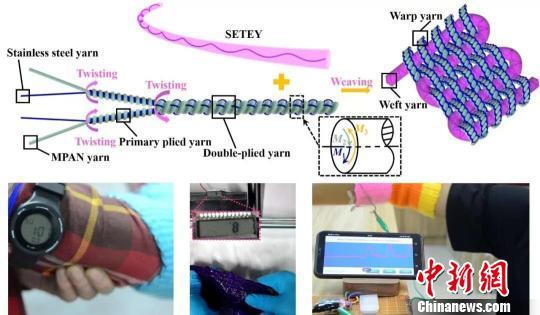
The weaving process of the power generation fabric is demonstrated with the wearable application.
Sino-Singapore Online February 21st (Gong Wei Xu) Donghua University announced on the 21st that the school's research group Wang Hongzhi's research group has made new progress in the field of wearable energy, the relevant research results are "amphibious energy yarn and The issue of continuous and large-scale preparation of textiles was published in the internationally renowned academic journal Nature Communications.
The research team believes that fiber, yarn and fabric will become the next generation power generation carrier. However, mature power generation technologies, such as photovoltaics, thermoelectrics, piezoelectric/triboelectrics, and other combinations of clothing materials and textile industry still have challenges. At present, energy textiles are difficult to produce on a large scale, and the performance of energy devices is susceptible to environmental humidity, and there is still a lack of technology for generating electricity using a single yarn. The development of "energy clothing" still has a long way to go.
With the rapid development of wearable electronic devices, the demand for wearable energy has gradually increased. Due to the limitations of traditional batteries, such as lack of flexibility, non-stretching, and difficulty in weaving, flexible portable energy materials and devices have gained a lot of attention. Most of the current research on wearable power supplies showcases the "wearing" form of energy devices, which are primarily used as add-ons to clothing and still lack wearing comfort. In contrast, the clothing body is a ready-made physical carrier, which is a more ideal wearable function integration platform.
In this work, the researchers used industrial grade spinning equipment to achieve continuous and large-scale production of stretchable triboelectric yarns, and explored the single-electrode potential well model of metal/amorphous polymer contact/separation. The hypothesis of the potential/polarization coupling effect of a triboelectric device is first proposed. Thanks to the special core-core design and coupled gain generator system, the power generation yarn reported in this work can generate electricity by itself without interaction with other objects, and can be applied to different atmospheres or even liquids.
Researchers used industrial grade weaving machines to weave power-generating yarns to produce elastic power-generating fabrics that also have the capability of amphibious work. The power generation yarn can also be woven together with other commercially available fibers such as nylon fiber and polyacrylonitrile fiber, and the vapor permeability, comfort and power generation of the textile can be effectively regulated. The researchers wore "energy clothing" made of power-generating fabrics, demonstrating their functions of charging lithium batteries for electronic devices, driving wireless signal transmission systems, and capturing human body movements.
Donghua University is the first completed unit of the thesis. Gong Wei, the first post-graduate student of the Donghua University School of Materials, is the first author, Hou Chengyi, associate researcher, Zhang Qinghong, and Wang Hongzhi are co-authors. The research work has been heavily funded by the Central University's basic research business fee discipline cross-key project, the China Association for Science and Technology Young Talents Support Project, and the Donghua University Inspirational Program.
According to reports, the Advanced Functional Material Group (AFMG) is affiliated to the Materials School of Donghua University. The team of instructors includes Professor Wang Hongzhi, Professor Li Yaogang, Zhang Qinghong, and Hou Chengyi. The research team has been engaged in the research of functional materials such as intelligent color change/deformation, energy conversion and storage, sensing and catalysis, especially for the application of smart clothing, and developed a series of flexible wearable functional materials and fiber devices. He has published more than 200 papers in internationally renowned academic journals such as Science Advances, Nature, Chemical Reviews, Chemical Society Reviews, Advanced Materials, Advanced Functional Materials, ACSNano, PNAS, Angewandte Chemie-International Edition, etc. More than 120 items. The research group actively carries out cooperation and exchanges at home and abroad. At present, it has cooperated with world-class universities such as Cambridge University, Yale University, Northwestern University, UCLA, Danish University of Science and Technology, Nanyang Technological University and Kyoto University. Doctoral student. (Finish)
Babydolls are cute and sexy pajamas consisting of loose tops and skirts, usually with some lace or ruffle trim. Babydolls can make you look young, lively and sweet, and also show off your beautiful legs and curves. Our dolls come in a variety of colors including red, blue, black and more. You can choose the right babydoll according to your mood and occasion, so that you can look charming at bedtime or on a date.
Other Lingerie recommendations, such as sexy bodydolls and Corsets, etc.
Babydolls Lingerie,Sexy Babydoll Lingerie,Women's Babydolls Dress,Babydolls Dress Lingerie,Lace Babydolls Set
FOSHANSHI NANHAI KAISIWA NEIYI CO.,LTD. , https://www.loveyousexyunderwear.com